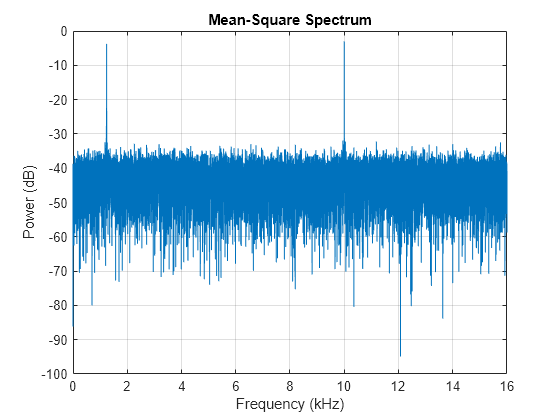dspdata.msspectrum
Mean-square (power) spectrum
Syntax
Hmss = dspdata.msspectrum(Data)
Hmss = dspdata.msspectrum(Data,Frequencies)
Hmss = dspdata.msspectrum(...,'Fs',Fs)
Hmss = dspdata.msspectrum(...,'SpectrumType',SpectrumType)
Hmss = dspdata.msspectrum(...,'CenterDC',flag)
Description
Note
The use of dspdata.msspectrum is not recommended.
Use periodogram or pwelch instead.
The mean-squared spectrum (MSS) is intended for discrete spectra. Unlike the power spectral density (PSD), the peaks in the MSS reflect the power in the signal at a given frequency. The MSS of a signal is the Fourier transform of that signal's autocorrelation.
Hmss = dspdata.msspectrum(Data) uses
the mean-square (power) spectrum data contained in Data,
which can be in the form of a vector or a matrix, where each column
is a separate set of data. Default values for other properties of
the object are as follows:
Property | Default Value | Description |
|---|---|---|
Name |
| Read-only character vector |
|
type | Vector of frequencies at which the spectrum is evaluated.
The range of this vector depends on the The length of the If
you do not specify If |
|
| Sampling frequency, which is |
|
| Nyquist interval over which the spectral density is calculated.
Valid values are The interval for |
|
| Whether the frequency is normalized ( |
Hmss = dspdata.msspectrum(Data,Frequencies) uses
the mean–square spectrum data contained in Data and Frequencies vectors.
Hmss = dspdata.msspectrum(...,'Fs',Fs) uses
the sampling frequency Fs. Specifying Fs uses
a default set of linear frequencies (in Hz) based
on Fs and sets NormalizedFrequency to false.
Hmss = dspdata.msspectrum(...,'SpectrumType',SpectrumType) uses SpectrumType to
specify the interval over which the mean-square spectrum was calculated.
For data that ranges from [0 π)
or [0 π], set the SpectrumType to onesided;
for data that ranges from [0 2π),
set the SpectrumType to twosided.
Hmss = dspdata.msspectrum(...,'CenterDC',flag) uses
the value of flag to indicate whether the zero-frequency
(DC) component is centered. If flag is true,
it indicates that the DC component is in the center of the two-sided
spectrum. Set the flag to false if
the DC component is on the left edge of the spectrum.
Methods
Methods provide ways of performing functions directly on your dspdata object
without having to specify the parameters again. You can apply a method
directly on the variable you assigned to your dspdata.msspectrum object.
You can use the following methods with a dspdata.msspectrum object.
centerdcnormalizefreqonesidedplotsfdrtwosided
For example, to normalize the frequency and set the NormalizedFrequency parameter
to true, use
Hmss = normalizefreq(Hs)
For detailed information on using the methods and plotting the
spectrum, see the dspdata reference
page.
Examples
Version History
Introduced before R2006a
